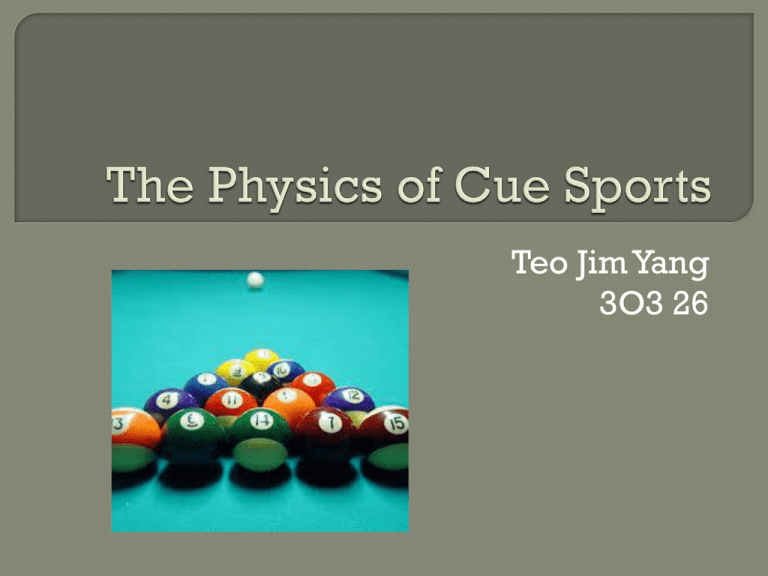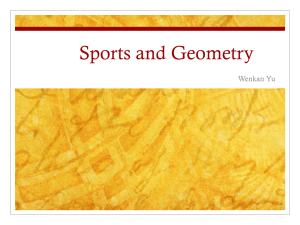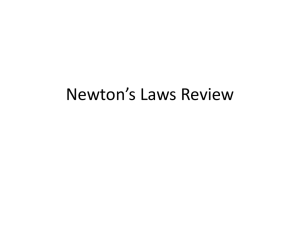cue ball - 2010SMTPSec3
advertisement

Teo Jim Yang 3O3 26 Introduction to Cue Sports Physics Concepts Involved in Cue Sports Before Collision: Hitting the Cue Ball During Collision: When the Cue Ball hits the Object Ball After Collision: The Motion Path of the Cue Ball Kicks and Banks: How to pot the Object Balls efficiently Using a cue stick, the objective is to strike the cue ball to hit other billiard balls into one of six pockets or pots on a billiard table Generally known as billiards, but has many sub-categories including: • Snooker • Pool (pocket billiards) • Carom Billiards Kinematics and • Velocity • Acceleration • Momentum • Impulse Friction Angular Dynamics Momentum (or Spin) The physics of billiards is a lot similar to the way light rays behave! Velocity (displacement/time) • The speed at which the balls move across the table • Dependent on the force exerted by the cue stick Acceleration (displacement/velocity) • The rate of change in speed • Speeds up and slows down due to human force (via the cue stick) and frictional force respectively Momentum (mass x velocity) • When one ball hits another, the first will impart velocity to the second through momentum • When the cue ball hits another ball, the other ball will move with similar velocity, but the cue ball will slow, if not halt altogether • The total momentum of the system, before, during, and after the hit remains the same Impulse (mass x change in velocity) • Change in momentum of an object over time • Describes the collision and transference of velocity from ball to ball A billiard table is made to be as flat as possible, with few surface imperfections • Insures that game play is predictable and consistent between tables Table material: Felt • Slows down the movement of the balls considerably • As the ball rolls across the table, the fibres in the felt gently push on the surface of the ball, producing spin Before Collision Mass x Directional Velocity Occurs when the cue ball is hit off-center • Just like when a light ray enters a medium, it will refract unless it enters perpendicular to the medium 3 types of billiards spin • Follow • Draw • English It is a form of momentum, thus: • Can be imparted from one ball to another Follow Caused by hitting the ball above the horizontal plane Draw Caused by hitting below the horizontal plane English Caused by hitting the ball somewhere on either side of the vertical plane Center ball (hitting it dead center) It slides for a short distance before rolling The harder the ball is hit, the farther it slides before the ball is rolling Draw (below center) First the ball rotates backward This rotation slows as the ball slides, and then the ball rolls forward as it does on other shots The harder the ball is hit, the farther the ball will travel with this backward spin If the cue ball hits another ball solidly when it still is spinning backwards, this backward spin will make it come back toward you after the collision Follow (above center) Cue ball rotates forward If the cue ball then hits another ball, it will roll forward after the collision Stop Shot (cue ball stops after collision) • The cue ball slides to the object ball and stops dead as the object ball shoots ahead because of the collision • Can be accomplished using center ball or draw Jump Shot (cue ball ‘jumps’ over one billiard ball to hit another) • Impart extreme spin on the cue ball or elevate greatly the cue stick • Jump Shot Example • A shorter jump cue makes the jump higher and more dramatic • The type and thickness of the cloth may also be a factor in how high the cue ball jumps The area of the cue ball where it is struck so that no friction force develops between the ball and the table Pure rolling of the ball will always result after impact During Collision When two billiard balls collide the collision is nearly elastic • An elastic collision is one in which the kinetic energy of the system is conserved before and after impact Conservation of Energy • Energy cannot be created nor destroyed; only transferred from one object to another • KE is thus transferred from ball-to-ball during collisions In the simplest case, when a cue ball hits an object ball in a straight line, the resulting path of the object ball will be along the line that connects the center of the two balls at contact 90 Degree Rule: The resulting path of the cue ball will be perpendicular (90 degrees) to that line When the cue ball hits the object ball at an angle, the 90 Degree Rule still applies The line L1 is drawn at a tangent to both balls at the point of contact • L1 is perpendicular to the line passing through the centre of the two balls and the contact point CP • L1also makes an angle θ with the vertical, and the line passing through the centre of the balls makes an angle θ with the horizontal. After impact at CP, ball B moves in the direction of the line joining the centre of the two balls (blue line) Force delivered by ball A to ball B acts normal to the surface of ball B, Thus, ball B moves in the direction of this force After impact, ball A moves in a direction perpendicular to the direction of ball B Using a vector diagram of the blue, green and red lines (the displacement of the balls before and after collision), the relationship between the forces can be easily seen: However, the resultant direction of the object ball after collision usually deviates slightly due to frictional force with the table This deviation is known as throw This is common when the cue ball is struck English or when the cue ball strikes the object ball at an angle When the cue ball is given side English, as in the diagram, it spins anti-clockwise Similar to the movement of gears, the red and yellow balls spin in the opposite direction to the adjacent ball This causes the yellow ball to be ‘thrown’ to the right After Collision If the cue ball had center ball during collision, it should move at a right angle to the path of the object ball (perpendicular) With follow, the cue ball will curve forward With draw, the cue ball will curve backward Kicks and Banks Donald The Duck and Billiards video shows how the paths of the balls can be perfected by using concepts of physics and mathematics A bank shot is when you drive an object ball into the rail (side of the table) and then into a pocket, somewhere on the other side of the table A kick shot is when you drive the cue ball into the rail, and then into the object ball This is a lot like the reflection of a light ray off a mirror There are many ways to accomplish kick and bank shots • Bank Shot • Kick Shot By using physics concepts, cue sports can be more easily understood and picked up On the other hand, using cue sports is also a fun way to understand physics concepts better http://www.klsgametables.com/english.htm l http://www.pool-billiardsgame.com/billiard-drills.html http://www.trickshottim.com/learn/poolphysics.html http://www.real-world-physicsproblems.com/physics-of-billiards.html http://www.jimloy.com/billiard/phys.htm http://www.suite101.com/content/billiardsand-angular-momentum-a24691 http://www.billiardworld.com/index.html







